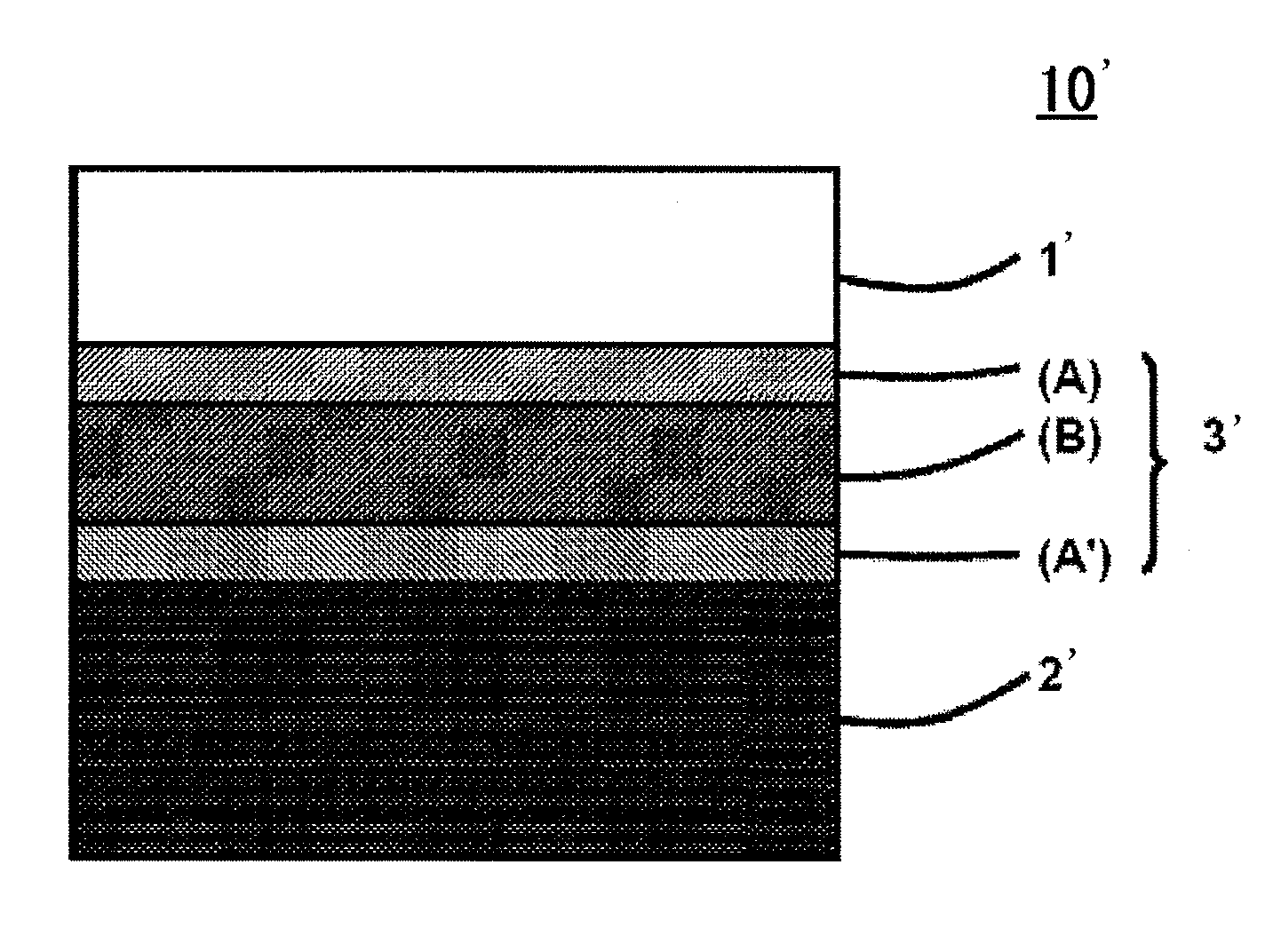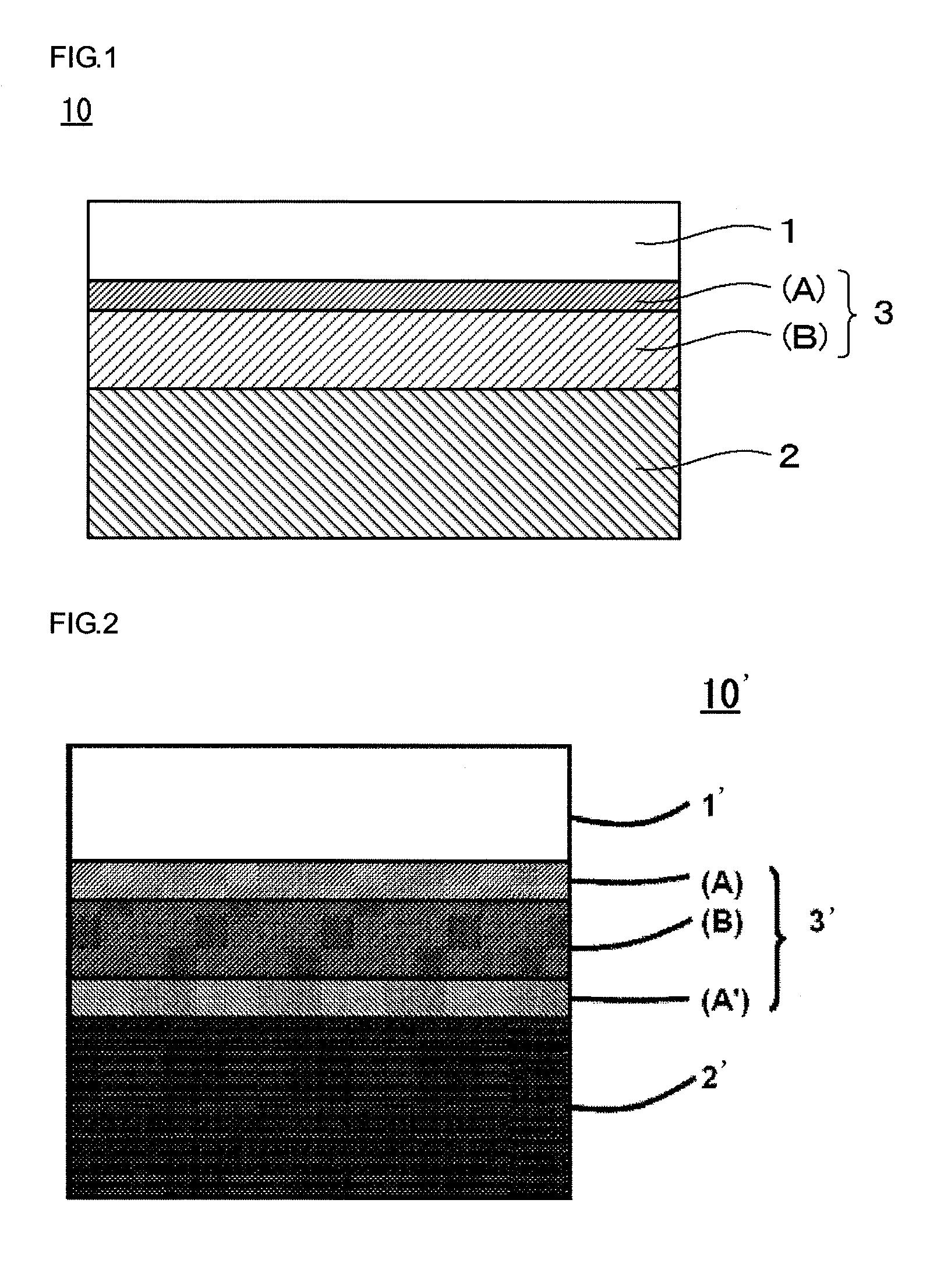Wafer process body, wafer processing member, wafer processing temporary adhesive material, and method for manufacturing thin wafer
a technology of temporary adhesive and wafer, which is applied in the direction of film/foil adhesives without carriers, film/foil adhesives, transportation and packaging, etc. it can solve the problems of deformation of resin and fouling of equipment during processing, the adhesion between the supporting body and the wafer is so strong and hard, and the removal is difficult. , to achieve the effect of high heat resistance, easy breakage, and easy detachment from the supporting body
- Summary
- Abstract
- Description
- Claims
- Application Information
AI Technical Summary
Benefits of technology
Problems solved by technology
Method used
Image
Examples
synthesis example 1
[0132]Into a 1-L flask equipped with a stirrer, a cooling equipment, and a thermometer were taken 234 g (13 moles) of water and 35 g of toluene; and then, they were heated at 80° C. in an oil bath. Into a dropping funnel were taken 183.6 g (0.8 mole) of norbornyl trichloro silane, 12.9 g (0.1 mole) of dimethyl dichloro silane, and 10.9 g (0.1 mole) of trimethyl chloro silane; and then, this mixture was gradually added into the flask in one hour with stirring. After completion of the addition, heating was further continued for aging at 80° C. for one hour. The resulting mixture was cooled statically to room temperature, and then, the separated aqueous layer was removed. After the organic layer was mixed with a 10% aqueous solution of sodium sulfate with stirring for 10 minutes, this mixture was allowed to stand for 30 minutes, and then, the separated aqueous layer was removed. This washing operation by water to remove the separated aqueous layer was repeated until the toluene layer b...
synthesis example 2
[0134]Similarly to Synthesis Example 1, 234 g (13 moles) of water and 35 g of toluene were taken into a 1-L flask; and then, they were heated at 80° C. in an oil bath. The subsequent procedures were followed similarly to Synthesis Example 1 except that 206.6 g (0.9 mole) of norbornyl trichloro silane, 7.1 g (0.05 mole) of methyl vinyl dichloro silane, and 5.4 g (0.05 mole) of trimethyl chloro silane were taken into a dropping funnel; and as a result, 140 g of a solid organopolysiloxane (Resin 2) was obtained.
[0135]The obtained organopolysiloxane contained 90 mol % of the T Unit, 5 mol % of the D unit, and 5 mol % of the M Unit. In addition, 0.1 mole of the terminal silanol group and 0.034 mole of the terminal vinyl group per 100 g of the organopolysiloxane. The appearance thereof was a colorless and transparent solid with the weight-average molecular weight of 5,900. Contents of the norbornyl group and the vinyl group, relative to totality of the organic groups and the hydrogen atom...
synthesis example 3
[0136]As the alkenyl-containing oreganopolysiloxane (A1), 100 g of the solid organopolysiloxane (Resin 2) obtained by Synthesis Example 2 was dissolved into 100 g of toluene to obtain a solution with the solid concentration thereof being 50%. Into this solution was added a platinum catalyst with the amount thereof being 20 ppm as the platinum atom relative to the resin; and then, 27.5 g of the compound (SiH equivalent of 1473 g / mol) shown by the following formula (9) as the hydrosilyl-containing compound (A2) was gradually added thereinto at 60° C. At this time, heat generation due to the reaction was recognized. This amount corresponds to 0.55 of the H / Vi ratio (ratio of the SiH group to totality of the alkenyl group). The reaction was carried out at 100° C. for two hours to complete the reaction. Thereafter, toluene was removed by vacuum distillation to obtain a solidified reaction product, which was then redissolved into isododecane. The resulting solution was filtrated through a...
PUM
| Property | Measurement | Unit |
|---|---|---|
| mol % | aaaaa | aaaaa |
| mol % | aaaaa | aaaaa |
| temperature | aaaaa | aaaaa |
Abstract
Description
Claims
Application Information
 Login to View More
Login to View More - R&D
- Intellectual Property
- Life Sciences
- Materials
- Tech Scout
- Unparalleled Data Quality
- Higher Quality Content
- 60% Fewer Hallucinations
Browse by: Latest US Patents, China's latest patents, Technical Efficacy Thesaurus, Application Domain, Technology Topic, Popular Technical Reports.
© 2025 PatSnap. All rights reserved.Legal|Privacy policy|Modern Slavery Act Transparency Statement|Sitemap|About US| Contact US: help@patsnap.com



